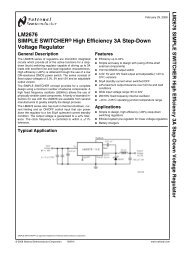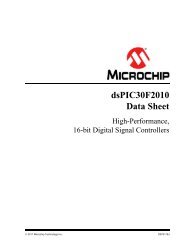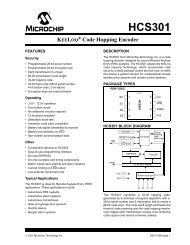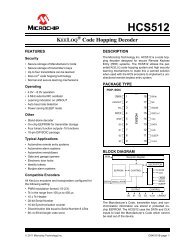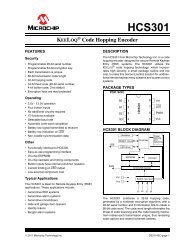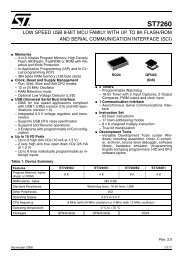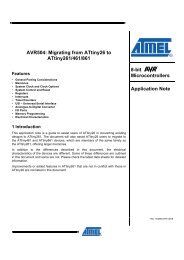You also want an ePaper? Increase the reach of your titles
YUMPU automatically turns print PDFs into web optimized ePapers that Google loves.
<strong>STM32W108C8</strong><br />
Interrupts<br />
12 Interrupts<br />
The <strong>STM32W108C8</strong>'s interrupt system is composed of two parts: a standard ARM® Cortex-<br />
M3 Nested Vectored Interrupt Controller (NVIC) that provides top level interrupts, and an<br />
Event Manager (EM) that provides second level interrupts. The NVIC and EM provide a<br />
simple hierarchy. All second level interrupts from the EM feed into top level interrupts in the<br />
NVIC. This two-level hierarchy allows for both fine granular control of interrupt sources and<br />
coarse granular control over entire peripherals, while allowing peripherals to have their own<br />
interrupt vector.<br />
The Section 12.3: Nested vectored interrupt controller (NVIC) interrupts provides a<br />
description of the NVIC and an overview of the exception table (ARM nomenclature refers to<br />
interrupts as exceptions) and Section 12.2: Event manager provides a more detailed<br />
description of the Event Manager including a table of all top-level peripheral interrupts and<br />
their second-level interrupt sources.<br />
In practice, top-level peripheral interrupts are only used to enable or disable interrupts for an<br />
entire peripheral. Second-level interrupts originate from hardware sources, and therefore<br />
are the main focus of applications using interrupts.<br />
12.1 Nested vectored interrupt controller (NVIC)<br />
The ARM® Cortex-M3 Nested Vectored Interrupt Controller (NVIC) facilitates low-latency<br />
exception and interrupt handling. The NVIC and the processor core interface are closely<br />
coupled, which enables low-latency interrupt processing and efficient processing of late<br />
arriving interrupts. The NVIC also maintains knowledge of the stacked (nested) interrupts to<br />
enable tail-chaining of interrupts.<br />
The ARM® Cortex-M3 NVIC contains 10 standard interrupts that are related to chip and<br />
CPU operation and management. In addition to the 10 standard interrupts, it contains 17<br />
individually vectored peripheral interrupts specific to the <strong>STM32W108C8</strong>.<br />
The NVIC defines a list of exceptions. These exceptions include not only traditional<br />
peripheral interrupts, but also more specialized events such as faults and CPU reset. In the<br />
ARM® Cortex-M3 NVIC, a CPU reset event is considered an exception of the highest<br />
priority, and the stack pointer is loaded from the first position in the NVIC exception table.<br />
The NVIC exception table defines all exceptions and their position, including peripheral<br />
interrupts. The position of each exception is important since it directly translates to the<br />
location of a 32-bit interrupt vector for each interrupt, and defines the hardware priority of<br />
exceptions. Each exception in the table is a 32-bit address that is loaded into the program<br />
counter when that exception occurs. Table 122 lists the entire exception table. Exceptions 0<br />
(stack pointer) through 15 (SysTick) are part of the standard ARM® Cortex-M3 NVIC, while<br />
exceptions 16 (Timer 1) through 32 (Debug) are the peripheral interrupts specific to the<br />
<strong>STM32W108C8</strong> peripherals. The peripheral interrupts are listed in greater detail in<br />
Table 123.<br />
Doc ID 018587 Rev 2 174/215





